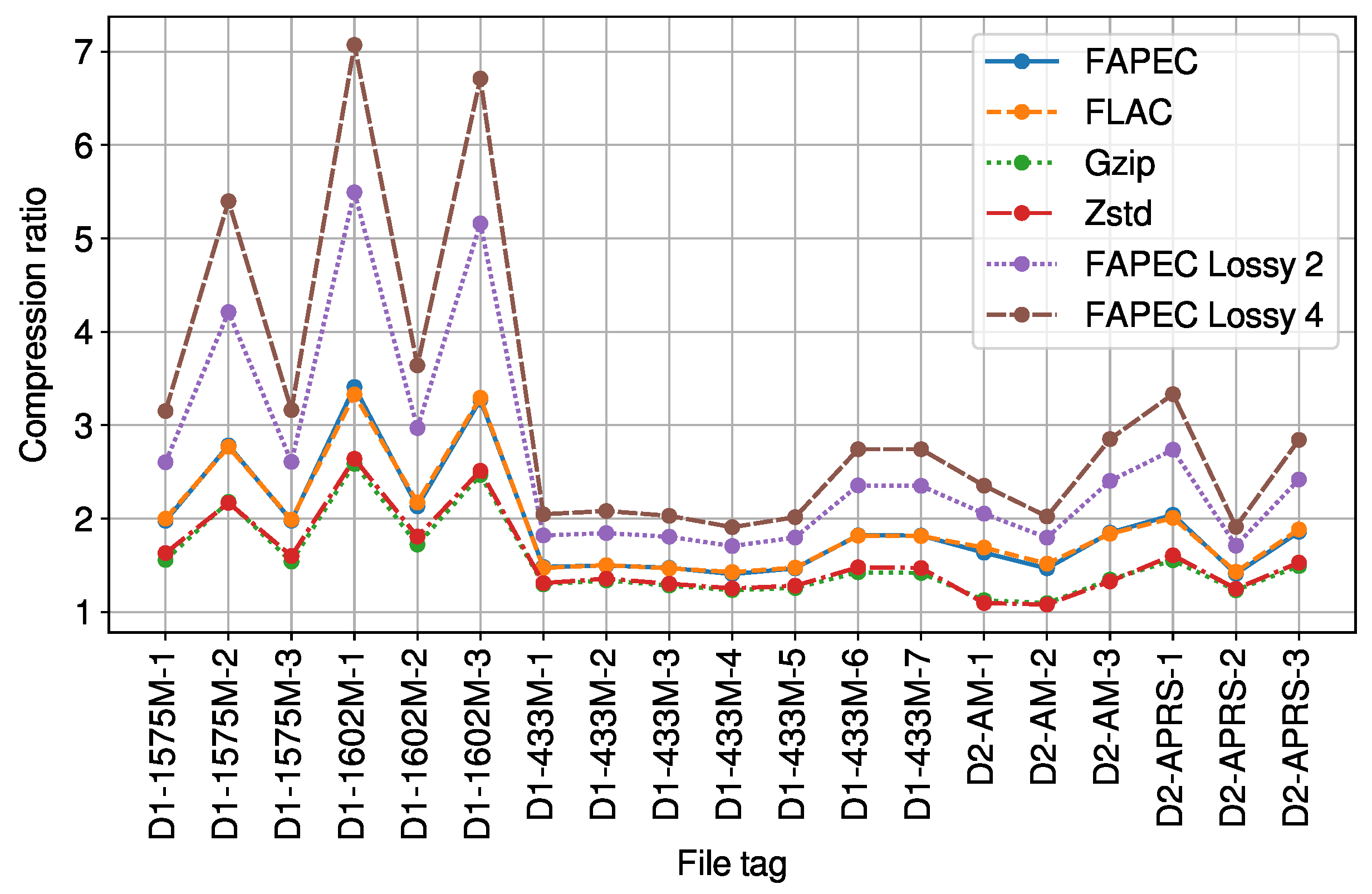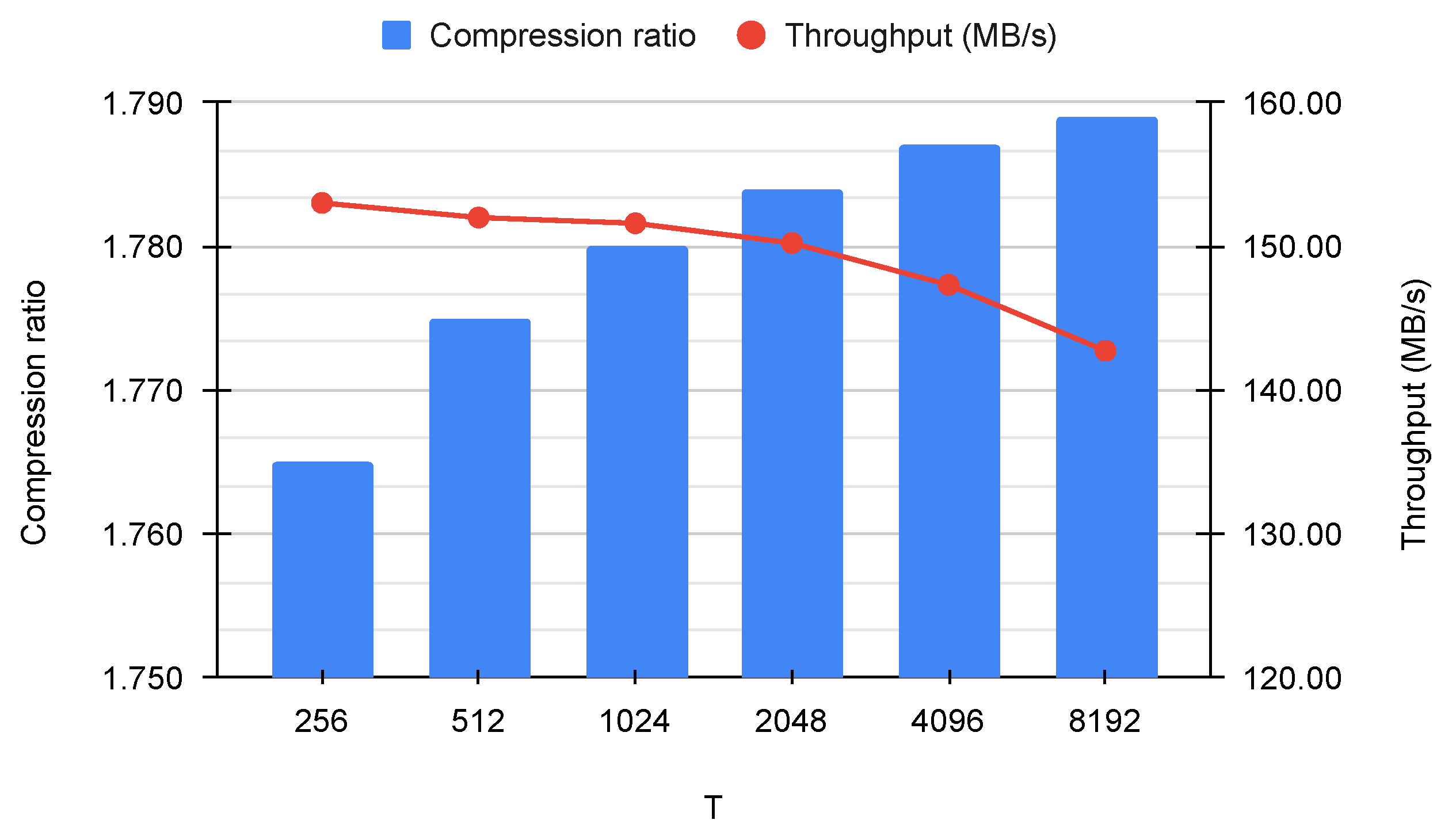Context-Aware Lossless and Lossy Compression of Radio Frequency Signals
Abstract
1. Introduction
2. RF Signals Data Format
3. The FAPEC Data Compressor
4. FAPEC Tailoring for RF Data
4.1. General Aspects of the Proposed Algorithm
4.2. Smart Lossy
5. Test Setup
6. Test Results
6.1. Lossless and Near-Lossless Compression
6.2. Smart Lossy
7. Conclusions and Future Work
Author Contributions
Funding
Institutional Review Board Statement
Informed Consent Statement
Data Availability Statement
Acknowledgments
Conflicts of Interest
Abbreviations
| AIC | Akaike Information Criterion |
| AM | Amplitude Modulation |
| APRS | Automatic Packet Reporting System |
| BER | Bit Error Rate |
| CLT | Central Limit Theorem |
| ESA | European Space Agency |
| FAPEC | Fully Adaptive Prediction Error Coder |
| FFT | Fast Fourier Transform |
| FLAC | Free Lossless Audio Codec |
| GNSS | Global Navigation Satellite System |
| IQ | In-phase and Quadrature |
| LPC | Linear Predictive Coding |
| LSB | Least Significant Bits |
| RF | Radio Frequency |
| SDR | Software-Defined Radio |
| SNR | Signal-to-Noise Ratio |
| WSS | Wide Sense Stationary |
References
- Wang, B.; Liu, K.R. Advances in cognitive radio networks: A survey. IEEE J. Sel. Top. Signal Process. 2011, 5, 5–23. [Google Scholar] [CrossRef]
- Borràs, J.; Font-Segura, J.; Riba, J.; Vázquez, G. Dimension spreading for coherent opportunistic communications. In Proceedings of the 2017 51st Asilomar Conference on Signals, Systems, and Computers, Pacific Grove, CA, USA, 29 October–1 November 2017. [Google Scholar]
- Manco, J.; Dayoub, I.; Nafkha, A.; Alibakhshikenari, M.; Thameur, H.B. Spectrum Sensing in Software Defined Radio for Cognitive Radio Networks: A Survey. IEEE Access 2022, 10, 131887–131908. [Google Scholar] [CrossRef]
- Sandau, R. Status and trends of small satellite missions for Earth observation. Acta Astronaut. 2010, 66, 1–12. [Google Scholar]
- Nanba, S.; Agata, A. A new IQ data compression scheme for front-haul link in Centralized RAN. In Proceedings of the IEEE 24th International Symposium on Personal, Indoor and Mobile Radio Communications (PIMRC Workshops), London, UK, 8–9 September 2013. [Google Scholar]
- Badger, R.D.; Kim, M. Singular Value Decomposition for Compression of Large-Scale Radio Frequency Signals. In Proceedings of the 2021 29th European Signal Processing Conference (EUSIPCO), Dublin, Ireland, 23–27 August 2021. [Google Scholar]
- Carlson, A. Communication Systems; McGraw-Hill Education: New York, NY, USA, 2010. [Google Scholar]
- Portell, J.; Iudica, R.; García-Berro, E.; Villafranca, A.G.; Artigues, G. FAPEC, a versatile and efficient data compressor for space missions. Int. J. Remote Sens. 2018, 39, 2022–2042. [Google Scholar] [CrossRef]
- Salomon, D.; Motta, G.; Bryant, D. Data Compression: The Complete Reference; Springer: London, UK, 2007. [Google Scholar]
- Hernández-Cabronero, M.; Portell, J.; Blanes, I.; Serra-Sagristà, J. High-Performance Lossless Compression of Hyperspectral Remote Sensing Scenes Based on Spectral Decorrelation. Remote Sens. 2020, 12, 2955. [Google Scholar] [CrossRef]
- Martí, A.; Portell, J.; Amblas, D.; de Cabrera, F.; Vilà, M.; Riba, J.; Mitchell, G. Compression of Multibeam Echosounders Bathymetry and Water Column Data. Remote Sens. 2022, 14, 2063. [Google Scholar] [CrossRef]
- Portell, J.; Amblas, D.; Mitchell, G.; Morales, M.; Villafranca, A.G.; Iudica, R.; Lastras, G. High-Performance Compression of Multibeam Echosounders Water Column Data. IEEE J. Sel. Top. Appl. Earth Obs. Remote Sens. 2019, 12, 1771–1783. [Google Scholar] [CrossRef]
- Vaidyanathan, P.P. The Theory of Linear Prediction; Springer: Cham, Switzerland, 2008. [Google Scholar]
- Van Trees, H.; Bell, K.; Tian, Z. Detection Estimation and Modulation Theory, Part I: Detection, Estimation, and Filtering Theory; Wiley: Hoboken, NJ, USA, 2013. [Google Scholar]
- Kay, S.M. Modern Spectral Estimation: Theory and Application; Prentice Hall: Englewood Cliffs, NJ, USA, 1988. [Google Scholar]
- Nikonowicz, J.; Mahmood, A.; Sisinni, E.; Gidlund, M. Noise Power Estimators in ISM Radio Environments: Performance Comparison and Enhancement Using a Novel Samples Separation Technique. IEEE Trans. Instrum. Meas. 2019, 68, 105–115. [Google Scholar] [CrossRef]
- Sequeira, S.; Mahajan, R.R.; Spasojević, P. On the Noise Power Estimation in the Presence of the Signal for Energy-Based Sensing. In Proceedings of the 2012 35th IEEE Sarnoff Symposium, Newark, NJ, USA, 21–22 May 2012. [Google Scholar]
- Akaike, H. A new look at the statistical model identification. IEEE Trans. Autom. Control 1974, 19, 716–723. [Google Scholar] [CrossRef]
- Welch, P. The use of fast Fourier transform for the estimation of power spectra: A method based on time averaging over short, modified periodograms. IEEE Trans. Audio Electroacoust. 1967, 15, 70–73. [Google Scholar]
- Wax, M.; Kailath, T. Detection of signals by information theoretic criteria. IEEE Trans. Acoust. Speech Signal Process. 1985, 33, 387–392. [Google Scholar] [CrossRef]
- Yucek, T.; Arslan, H. A survey of spectrum sensing algorithms for cognitive radio applications. IEEE Commun. Surv. Tutor. 2009, 11, 116–130. [Google Scholar] [CrossRef]
- Nikonowicz, J.; Jessa, M. A novel method of blind signal detection using the distribution of the bin values of the power spectrum density and the moving average. Digital Signal Process. 2017, 66, 18–28. [Google Scholar] [CrossRef]
- Riba, J.; Villares, J.; Vázquez, G. A Nondata-Aided SNR Estimation Technique for Multilevel Modulations Exploiting Signal Cyclostationarity. IEEE Trans. Signal Process. 2010, 58, 5767–5778. [Google Scholar] [CrossRef]
- Riba, J.; Vilà, M. On Infinite Past Predictability of Cyclostationary Signals. IEEE Signal Process. Lett. 2022, 29, 647–651. [Google Scholar] [CrossRef]
- Martí, A.; Portell, J. Spectra. Released: 13 December 2022. Available online: https://doi.org/10.5281/zenodo.7432113 (accessed on 10 January 2023).
- OPS-SAT. 2017. Available online: https://www.esa.int/Enabling_Support/Operations/OPS-SAT (accessed on 10 January 2023).
- APRS Protocol Reference. 2000. Available online: http://www.aprs.org/doc/APRS101.PDF (accessed on 12 December 2022).
- Martí, A.; Portell, J.; Riba, J.; Mas, O. Dataset from: Context-Aware Lossless and Lossy Compression of Radio Frequency Signals. 2023. Available online: https://doi.org/10.21227/ccdy-s283 (accessed on 20 February 2023).
- Ziv, J.; Lempel, A. A universal algorithm for sequential data compression. IEEE Trans. Inf. Theory 1977, 23, 337–343. [Google Scholar] [CrossRef]
- Huffman, D.A. A Method for the Construction of Minimum-Redundancy Codes. Proc. IRE 1952, 40, 1098–1101. [Google Scholar] [CrossRef]
- Duda, J.; Tahboub, K.; Gadgil, N.J.; Delp, E.J. The use of asymmetric numeral systems as an accurate replacement for Huffman coding. In Proceedings of the 2015 Picture Coding Symposium (PCS), Cairns, Australia, 31 May–3 June 2015. [Google Scholar]




Disclaimer/Publisher’s Note: The statements, opinions and data contained in all publications are solely those of the individual author(s) and contributor(s) and not of MDPI and/or the editor(s). MDPI and/or the editor(s) disclaim responsibility for any injury to people or property resulting from any ideas, methods, instructions or products referred to in the content. |
© 2023 by the authors. Licensee MDPI, Basel, Switzerland. This article is an open access article distributed under the terms and conditions of the Creative Commons Attribution (CC BY) license (https://creativecommons.org/licenses/by/4.0/).
Share and Cite
Martí, A.; Portell, J.; Riba, J.; Mas, O. Context-Aware Lossless and Lossy Compression of Radio Frequency Signals. Sensors 2023, 23, 3552. https://doi.org/10.3390/s23073552
Martí A, Portell J, Riba J, Mas O. Context-Aware Lossless and Lossy Compression of Radio Frequency Signals. Sensors. 2023; 23(7):3552. https://doi.org/10.3390/s23073552
Chicago/Turabian StyleMartí, Aniol, Jordi Portell, Jaume Riba, and Orestes Mas. 2023. "Context-Aware Lossless and Lossy Compression of Radio Frequency Signals" Sensors 23, no. 7: 3552. https://doi.org/10.3390/s23073552
APA StyleMartí, A., Portell, J., Riba, J., & Mas, O. (2023). Context-Aware Lossless and Lossy Compression of Radio Frequency Signals. Sensors, 23(7), 3552. https://doi.org/10.3390/s23073552





